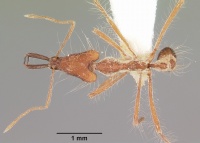Strumigenys gloriosa
| Strumigenys gloriosa | |
|---|---|

| |
| Scientific classification | |
| Kingdom: | Animalia |
| Phylum: | Arthropoda |
| Class: | Insecta |
| Order: | Hymenoptera |
| Family: | Formicidae |
| Subfamily: | Myrmicinae |
| Tribe: | Attini |
| Genus: | Strumigenys |
| Species: | S. gloriosa |
| Binomial name | |
| Strumigenys gloriosa Bolton, 2000 | |
Nothing is known about the biology of Strumigenys gloriosa.
Identification
Bolton (2000) - A member of the magnifica complex in the Strumigenys doriae-group. For comparative notes see under Strumigenys magnifica and Strumigenys doriae.
Keys including this Species
Distribution
Distribution based on Regional Taxon Lists
Indo-Australian Region: Borneo (type locality), Brunei Darussalam, Indonesia, Malaysia.
Distribution based on AntMaps
Distribution based on AntWeb specimens
Check data from AntWeb
Countries Occupied
| Number of countries occupied by this species based on AntWiki Regional Taxon Lists. In general, fewer countries occupied indicates a narrower range, while more countries indicates a more widespread species. |

|
Estimated Abundance
| Relative abundance based on number of AntMaps records per species (this species within the purple bar). Fewer records (to the left) indicates a less abundant/encountered species while more records (to the right) indicates more abundant/encountered species. |

|
Biology
Castes
Nomenclature
The following information is derived from Barry Bolton's Online Catalogue of the Ants of the World.
- gloriosa. Strumigenys gloriosa Bolton, 2000: 775 (w.q.) BORNEO.
Unless otherwise noted the text for the remainder of this section is reported from the publication that includes the original description.
Description
Worker
Holotype. TL 4.4, HL 1.26, HW 0.74, CI 59, ML 0.63, MI 50, SL 0.91, SI 123, PW 0.39, AL 1.26. Mandible without trace of preapical dentition. With apical fork of mandible in frontal view the dorsal and ventral teeth are of approximately equal length, are widely separated and form a broad U-shape. Lateral spongiform lobe of petiole broad posteriorly, tapering anteriorly and extending forward as far as the spiracle on the peduncle. Pilosity abundant everywhere, the main hairs extremely long and fine, subflagellate to flagellate. Longest projecting hairs on upper scrobe margin extremely elongate, about 0.75 X SL. Dorsum of head with erect hairs in front of highest point of vertex that are as long and spectacular as those located more posteriorly; the longest hairs easily exceed the maximum depth of the head in profile. Longest hairs on promesonotal dorsum are much longer than maxi mum depth of alitrunk. Between the bases of these promesonotal hairs is very dense short pubescence, so dense that the promesonotal dorsal outline, seen in profile, appears to have a furry pelt between the long hairs. On side of propodeum the standing pubescence is so dense that it obscures the spiracle in oblique dorsal view. Longest hairs on first gastral tergite about 0.52, approximately equal to the length of the tergite from base of limbus to apex of segment and distinctly longer than the maximum depth of the first gastral segment in profile.
Paratypes. TL 4.4-4.5, HL 1.23-1.27, HW 0.72-0.74, CI 57-60, ML 0.60-0.63, MI 48-50, SL 0.88-0.90, SI 119-122, PW 0.36-0.39, AL 1.26-1.28 (5 measured).
Type Material
Holotype worker, Malaysia: Sabah, Poring Hot Springs, 10.v.1987, no. 19a (Burckhardt & Lobl) (Musee d'Histoire Naturelle Genève).
Paratypes. 3 workers with same data as holotype; 4 workers and 2 queens (dealate) with same data but no. 13; 2 workers with same data but 6.v.1987, 500 m., no. 14; 1 worker with same data but 7.v.1987, 500 m., no. 14a; 3 workers with same data but 13.v.1987, 500 m., no.24a; 1 worker, Poring Hot Springs, Langanan Riv., 14.v.1987, 850 m., no.25a (MHNG, The Natural History Museum, Museum of Comparative Zoology).
References
- Bolton, B. 2000. The ant tribe Dacetini. Memoirs of the American Entomological Institute. 65:1-1028. (page 775, worker described)
References based on Global Ant Biodiversity Informatics
- Bolton, B. 2000. The Ant Tribe Dacetini. Memoirs of the American Entomological Institute 65
- Pfeiffer M.; Mezger, D.; Hosoishi, S.; Bakhtiar, E. Y.; Kohout, R. J. 2011. The Formicidae of Borneo (Insecta: Hymenoptera): a preliminary species list. Asian Myrmecology 4:9-58

